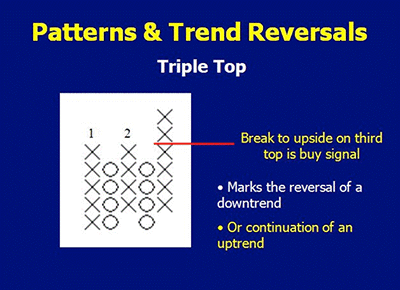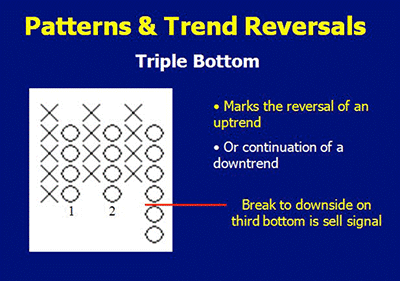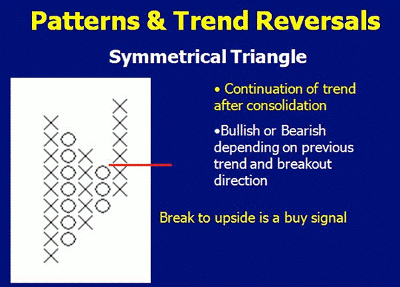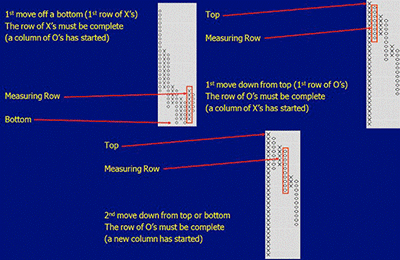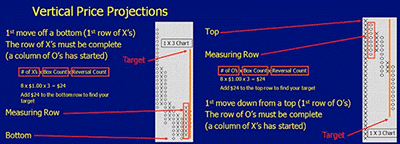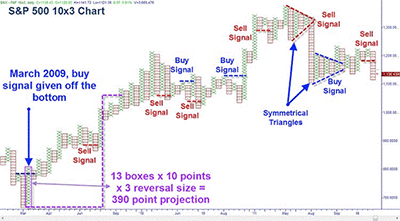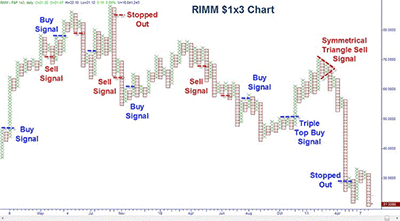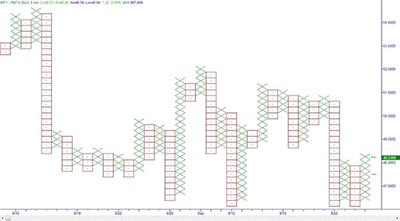Our studies of point and figure charting continue with additional methods for identifying price patterns and projecting targets for trades.
In the initial article on point and figure (P&F) charting, I discussed the basics of creating that style of chart. In this article, I will build upon that knowledge and show more advanced methods for identifying patterns and projecting price movement.
I want to mention that I tend to use this method of charting for longer-term swing or position trades rather than intraday trades. Remember that time is not a factor when attempting to achieve targets in P&F charting, and you will likely hold positions for some time.
Patterns in P&F charts are a bit different than what you may be used to in candlestick charting. A triple-top formation is not necessarily a reversal formation; it could be continuation. It will still offer a trading opportunity, however.
Look at the following examples of both the bullish and bearish triple formations.
Even patterns such as triangles are visible and tradable on P&F charts. They will work in much the same manner as they would on candlestick charts.
NEXT: The Vertical Price-Projection Method
|pagebreak|In the previous article, I discussed the use of horizontal price projections. Many traders choose a different price-projection method. If you are not using a one-box reversal chart and have instead selected a three-box (this refers to how much price would have to reverse for you to start a new column; $1x3 means price would have reversed a minimum of $3), you can try the vertical price-projection method. I have found this style to be more accurate in projecting targets.
The vertical price projection can only be made under certain circumstances. They are:
- First move off a bottom (first row of X’s)
- First move down from top (first row of O’s)
- Second move from top or bottom
Once you have counted the correct column, you can multiply that count by the per-box value and then multiply that number by the size for reversal. Your result should then be added to either the price bottom or subtracted from the price top to give you the price projection.
Now that we know the basics and what to look for, let’s examine a few P&F charts to see this technique in action. I have a chart of the S&P 500 in a 10x3 point and figure format. The 10 means I need a minimum ten-point move between closing prices to make a new box of X’s or O’s. I must also have a minimum of 30 points (10x3) to start a new column for a reversal.
I can do the same with charts of individual stocks. I have had to adjust the box size on the chart of Research in Motion (RIMM) due to its lower price.
If you are looking for smaller-duration trades, you can lessen the box size and also the closing periods. I had been using the daily closes on the previous charts.
In the following chart of Infosys (INFY), I set the box size at $0.25 and the reversal as three. What makes this more sensitive and allows me to see intraday activity is that I set the closing prices to every five minutes. Now, if the close from a five-minute period would cause a change in the chart, it is noted instead of waiting for the daily close.
By adjusting the box size and even what closing price the box will use, you can create all types of interesting charts to follow trends in the intraday (use $0.05 to $0.25 and close of five minutes), or even multi-decade trend-following charts. The possibilities are limitless.
By Brandon Wendell, instructor, Online Trading Academy

